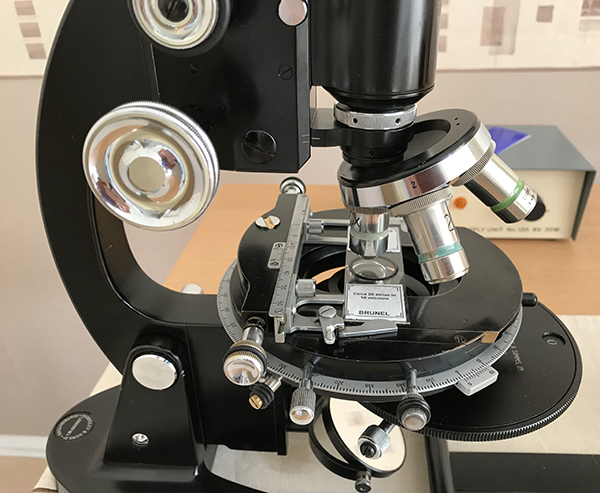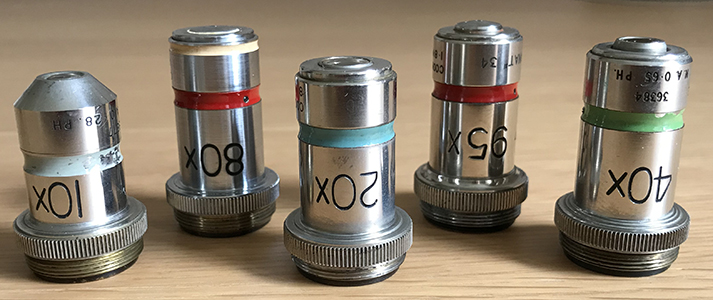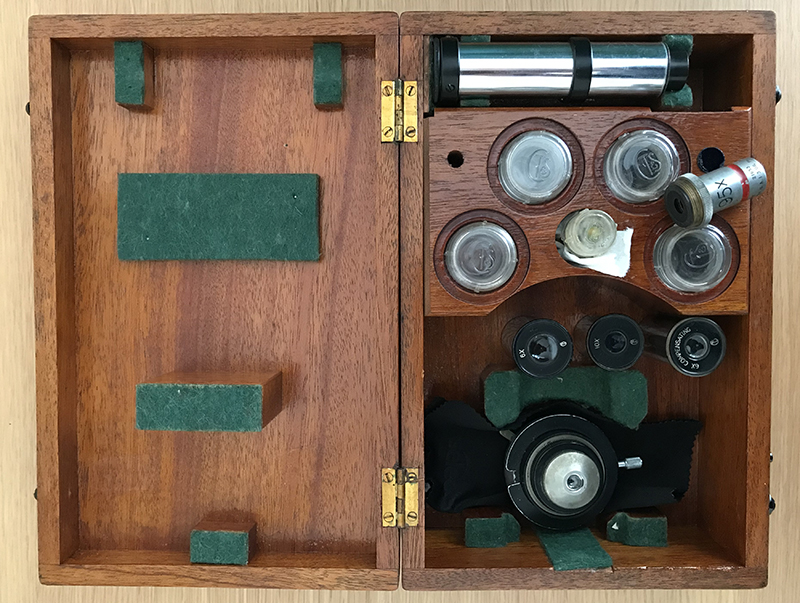
In September 1998 I wrote an article for Micscape on the CTS M2000 model equipped with phase entitled 'My Favourite Microscope'. It was acquired for a modest sum from work where it was being disposed of after a hard life. At the time, aside from my LOMO Biolam it was the only compound microscope owned. How the times have changed is reflected in that all imagery of and through the microscope used a video security camera with Nikon 35mm lens attached and stills captured with a video capture card at 640x480.
My brother Ian and I have owned, used and renovated where required a wide range of microscopes since, from 19th century brass and glass through to recent research scopes such as the Leitz Diaplan. We don't have the space or budget to keep a wide selection and tend to enjoy an outfit for some time, then sell and seek another. We enjoy exploring the many different makers, ages and types. I still have the Biolam as the first scope could afford in my early twenties. The workhorse I've now had for 15 years is a Zeiss Photomicroscope III with Zeiss optics although increasingly feel it is becoming a liability; the list of optics that have delaminated have kept growing (eyepieces, bino' head, objectives both achro' and apo'). I regularly check with trepidation that my 'bread and butter' optics for studies—the Neofluars and an expensive to buy DIC outfit remain sound. When budget permits we have slowly been building up a modern infinity system, a Nikon Eclipse 800.
We were keen to own a 'best of British' older model partly for display but immediately ready for occasional use mainly by my brother. The CTS models came to mind and a well kitted outfit caught our eye. The description below discusses aspects of this outfit and opinions on revisiting. The history of CTS and the features of the M2000 range have been discussed and illustrated in the earlier M2000 article.
 The outfit overall was in good condition but Ian spent some time sympathetically renovating; cosmetics, cleaning optics, degreasing and relubricating with modern Nye lubricants where necessary.
The outfit overall was in good condition but Ian spent some time sympathetically renovating; cosmetics, cleaning optics, degreasing and relubricating with modern Nye lubricants where necessary.
Lamp The outfit included a CTS lamp of the period which we have never seen or handled before which added to its appeal as a display item. The lamp is shown on page 183 of the Cooke Microscopes catalogue. It was designed for either a Pointolite, mercury vapour or ribbon filament lamp where the original beefy power supply is shown. The vertical design allows more efficient ventilation than for the 'High Power Low Voltage Lamp' with horizontal barrel shown on p.182. The lamp retains its Small Edison Screw SES fitting and came with an of the period bulb labelled 8V 48W [Edit: Corrected June 2024, not 6V.] (right, smaller bulb). Although it's not the correct design with an open coiled filament, the illumination is almost even with a 10X objective and for sub 10X powers or if phase not used, the condenser can be slipped off its dovetail and the concave mirror used. Filament shown lower right, the filament orientation does not look ideal on the mirror but visually was optimal to maximise even lighting.
Ian and I spent some time exploring potentially better modern bulbs including low voltage / mains for frosted / tungsten / LED. For mains it was rewired and fitted with an earth as was not setup for safe mains work as received. The bulbs tried did not offer sufficient improvements and were all designed for on-axis use rather than from the side so we settled for the original bulb supplied as most studies would be visual. The larger modern bulb shown right, for example, had poor side frosting with a thin long filament which was not in the correct plane. Modern LED 240V equivalents had a highly diffuse plastic envelope but not of high enough wattage. Converting an old lamp from low to mains voltage with a potentially deteriorating bulb holder insulation was also not deemed a safe long term option.
 Stand One of the delights of the CTS Mx000 compound microscope range is the fine focus which only acts on the nosepiece. Of the many microscopes which Ian and I have handled it is still hard to beat for an immediate light action. Unlike the previous M2000 owned, this example had the splendid rotating stage (below, M1346, p.116 of catalogue) which is built to a high standard and invaluable for polar studies and photomicrography. One slight ergonomic annoyance is that the locking screw for rotation is between the x and y controls. When viewing a subject and finding the stage controls by feel there is a tendency to grasp the locking screw instead of the desired x/y control.
Stand One of the delights of the CTS Mx000 compound microscope range is the fine focus which only acts on the nosepiece. Of the many microscopes which Ian and I have handled it is still hard to beat for an immediate light action. Unlike the previous M2000 owned, this example had the splendid rotating stage (below, M1346, p.116 of catalogue) which is built to a high standard and invaluable for polar studies and photomicrography. One slight ergonomic annoyance is that the locking screw for rotation is between the x and y controls. When viewing a subject and finding the stage controls by feel there is a tendency to grasp the locking screw instead of the desired x/y control.

Objectives The outfit came with a set of phase objectives 10X/0.28, 20X/0.45, 40X/0.65, 95X/1.3. For their age, the 10X and 20X have respectable NAs even by today's standards for achros. Modern budget stands often still retain a 20X/0.4 and a 10X is typically 0.25. Also in the outfit are three apos, a 20/0.65, a 40/0.95 dry with collar and 80X/1.32. Sadly the 20X and 40X are delaminating but not excessively so and remain competent performers. A darkfield stop for higher mag objectives also present.
One aspect of phase use that currently catches me out after using the Zeiss Photomic' for so long is remembering to open the condenser iris fully when using phase. On the Zeiss condenser it is designed so that the iris is not in the optics train when phase rings are chosen.



Eyepieces A pair of 6X and 10X compensating eyepieces for the bino' head are present and 6X and 10X single non-compensating. The eyepieces of this period by a number of makers often have very modest field nos compared with modern examples. These are all ca. 11 mm; low cf the 70s 18 mm Zeiss eyepieces. Ian and I have mixed feelings about the modern eyepieces with typical field nos. of 25 mm as used on the Nikon Eclipse. The older ones give a view surrounded by a black circle providing a contrasting background. Widefield eyepieces don't and also have to scan the field with the eyes as not all taken in by viewing centrally. We also like the lower mag eyepieces such as 6X rarely found on modern scopes. Coupled with modest NA objectives they can provide super crisp images. With modern optics all the detail is there and more with wide field eyepieces and high NA objectives but the view can be less dramatic as a need to focus through the subject.


Unlike the first CTS scope owned, this has the fitted out box for the phase outfit. The Abbe condenser also present and an original pot of oil.

The cabinet was in excellent condition. When formerly used in a lab, water staining from the bottom upwards is sometimes found. The mono' head on the right is a puzzle. A mirror sends the image to the angled side tube but it also has a vertical tube which serves no function as it is blanked off internally by the mirror. [EDIT June 2024. Somehow I missed that the chromed eyepiece tube pulls out sliding the prism out of the way to use the photo tube. Thank you to John Goodman of the Facebook CTS Microscope Users Group who pointed this out and notes that a similar design was used with the Leitz Panphot. The rather awkward eyepiece side view maybe because it was used with a macro stand with a camera support at the rear.] The vertical mono' head is engraved 'L.U.Z.D', possibly Liverpool University Zoological Dept.' London less likely which hosts multiple university colleges.
The scope is a delight to use. The demise of the English microscope manufacturing industry a few decades after this model was made has been well commented on by authors. Ian and I both enjoy owning an example of British engineering at its finest. It is hoped to share and comment on the performance of the optics in a later article.
Comments to the authors via David Walker are welcomed. Text by David, scope renovation and setting up by Ian. Opinions shared are by both authors.